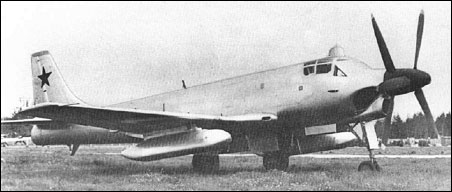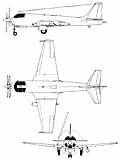 |
Tupolev Tu-911954 |  |
| SHIPBOARD BOMBER | Virtual Aircraft Museum / USSR / Russia / Tupolev |
 |
At the end of the 1940s, the Soviet government took a decision to expand the Voenno Morskoi Plot (VMF, the Navy). It was decided to include an aircraft carrier fleet, and development of aircraft suitable for carriers was a part of the programme. Tupolev was given the task of designing a strike aircraft for the new fleet. Vladimir Chizhevski was appointed chief designer. His team developed a two-seat low-wing monoplane, with a straight wing and with the engine located in the centre fuselage driving a long propeller shaft, which ran through the middle of the cockpit, and drove, through gears, two contra-rotating three-blade propellers. Josef Stalin died in March 1953, and the new leaders cut back the VMF expansion plans and thus the requirements for carrier-borne aircraft was cancelled. The naval chiefs, however, still saw a need for a strike aircraft, and Tupolev was asked instead to prepare a land-based aircraft for the role. This time Chizhevski was requested to design a dive bomber for attacking naval surface and submarine vessels; instead of carriers, it had to be capable of operating from runways of limited length. The Tu-91 required only relatively minor changes to meet the revised needs. The folding wings were now unnecessary and, with the arrestor hook, were removed and were replaced with conventional wings. The test programme began in autumn 1954 and went well. Both the factory tests and the state tests gave good results, and the aircraft was approved for production. Only the politicians remained to give their approval. In the summer of 1956, the latest examples of military aviation were unveiled to a group of high level officials, including the new General Secretary of the Communist Party, Nikita Khrushchev. Among all the gleaming examples of power and speed was the straight-winged Tu-91, one of very few propeller aircraft present and looking awkward in comparison with its neighbours. 'What's that?' Khrushchev asked a naval officer attending the aircraft. Confused momentarily by being addressed by Khrushchev, the officer, instead of replying that the aircraft could deliver firepower equal or greater than that of a heavy cruiser, answered that it could do the job of a cruiser. Thejovial Khrushchev then asked: 'So why do we need cruisers?' The career of the Tu-91 was over. Although Tupolev used all his connections and experience it was impossible to gain support from those under the leader.
|  COMPANY PROFILE | |||||||||||||||||||||||||||||||||||||||||||||||||||
 |

|

